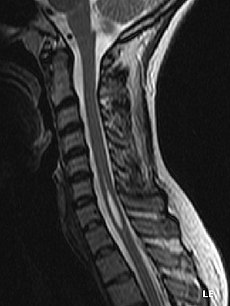 |
| Syringomyelia. See the thin light grey shape inside the spinal cord, placed at centre in the bottom half of the above image. |
We all hear the stories about people who willed away their paralysis. I don't want to say these stories are untrue or that these people are frauds, but often there is a very clear medical reason why some people recover from an injured spinal cord and the vast majority don't. It has a lot less to do with willpower than with what type of injury the person suffered, but because most regular folks aren't experts in spinal cord injury they think that willpower must be one answer.
I think that this thinking also spills over into how people view a successful adjustment to a life with paralysis. People that don't have just enough willpower to cure themselves, but have enough willpower to lead a happy life in the chair. Again, because the media hypes the stories about paralyzed people's success stories, those that aren't so successful end up being thought of as weak.
I guess this comes from people's basic understanding of paralysis, especially paraplegia (just the legs paralyzed). People tend to think of it as an injury that just knocks out your legs and therefore with a strong upper body (and willpower) it should be easy to get used to and lead a normal life. Again, if you can't, it's because of a lack of willpower.
People never think about, because it's never talked about, things like severe neuropathic pain, or pressure sores, or the hundreds of other secondary issues involved with paralysis. In the case of paraplegia, people tend to think that it's just the legs that don't work.
I've got a a new one that people have never thought of. Syringomyelia and I've got it. Basically this is when the spinal fluid enters the spinal cord and causes like a balloon filled with spinal fluid to grow inside the cord which eventually destroys the spinal cord. It often gets longer and goes up the spinal cord leading to sensory dysfunction, pain, weakness, and could lead to quadrapalegia as it gets longer and knocks out the arms.
How did I get this? Lack of willpower? Lack of adjustment to a life of paralysis? No, none of these things matter as you can't will it away or use your willpower to adjust.
No one knows the exact reason why or how it forms, but it forms due to a reaction to a spinal cord injury or hemmorage (which is what I had).
So please keep in mind when you read stories about those leading very successful lives despite their chairs, that not all injuries are the same and not all people suffer secondary complications from their injuries (even though most do and only a small minority lead the lives that you read about in the newspaper).
As of 26 October I'll be writing this blog from the hospital and I get ready for my operation on the 28th and then get moved to a rehab hospital. I'll be letting the surgeon use his skill to get rid of the syringomyelia and then use my skill to keep fighting for a cure for paralysis so things like syringomyelia and all the other complications of spinal cord injury get put into the history books.
Of course you need willpower to not give up hope, but I'm sorry to report, willpower doesn't cure paralysis..

